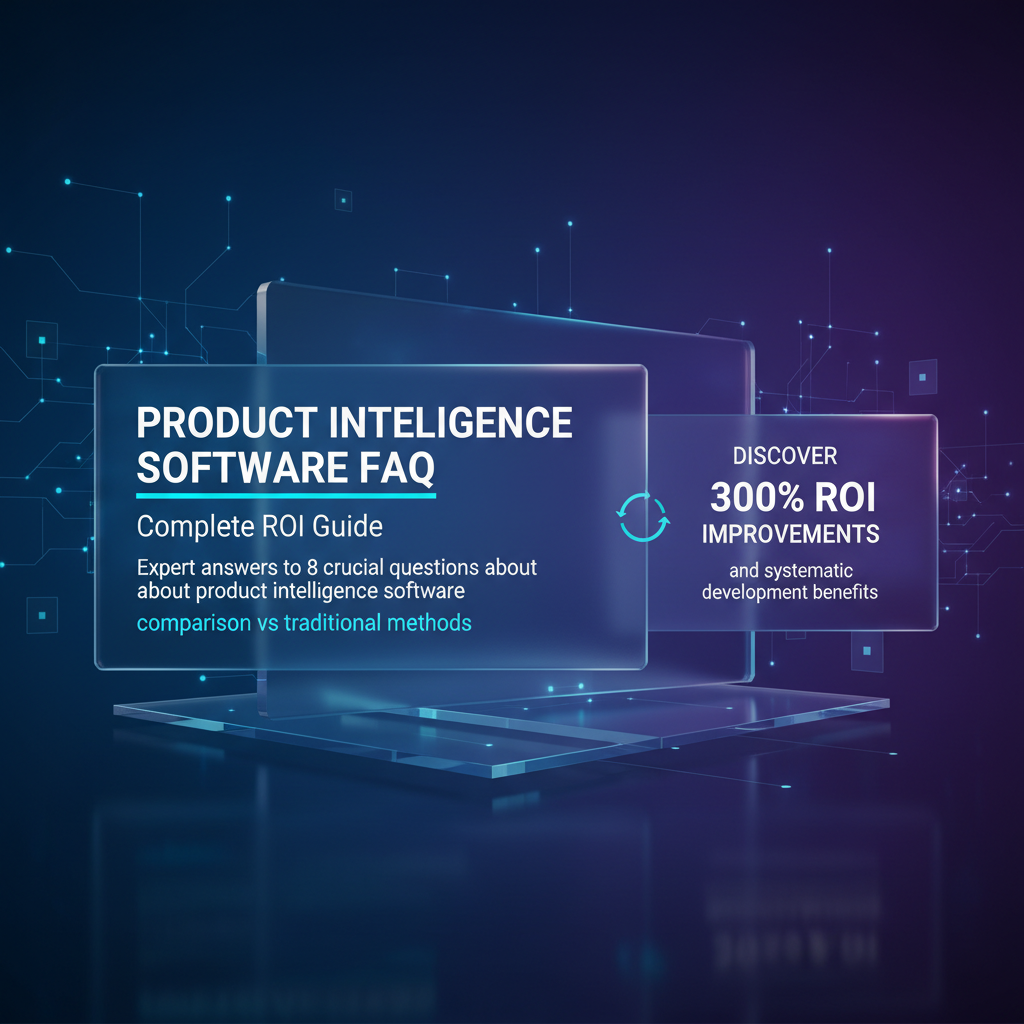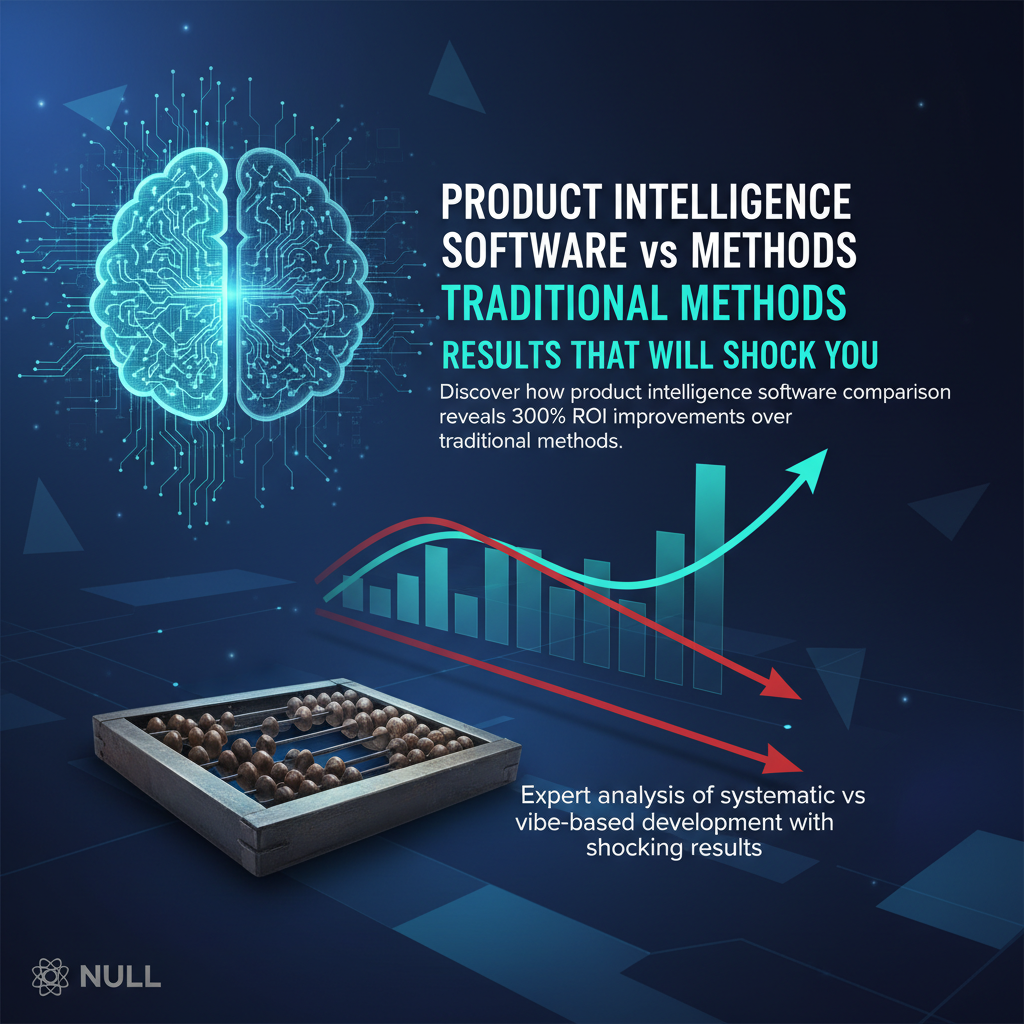glue.tools vs. Competitors: Complete 2025 Guide Reveals
Senior AI engineer Jordan Lin breaks down glue.tools vs. major competitors with real user data, feature comparisons, and 2025 product intelligence trends. Get the complete analysis.
Why Every Product Team is Asking About glue.tools vs. Competitors in 2025
Last week, my engineering lead Sarah pulled me aside after our sprint planning and said something that's been echoing in my head: "Jordan, we're building features faster than ever, but I have no idea if we're building the right things." This conversation happened right after we discovered that three of our last five major releases barely moved the needle on user engagement.
Sound familiar? You're not alone. After a decade of building AI systems and watching teams struggle with the same product management chaos, I've seen this pattern everywhere. Teams are drowning in feedback from Slack messages, support tickets, sales calls, and user interviews, but they're still making decisions based on gut feelings instead of systematic analysis.
That's exactly why glue.tools vs. competitors has become the hottest search among product teams in 2025. Everyone's realizing that traditional project management tools like Jira and Asana weren't built for the modern product intelligence era. They track what you're building, but they don't help you figure out what you should be building.
In this complete comparison guide, I'm going to break down how glue.tools stacks up against every major competitor in the product management space. We'll dive deep into pricing, features, AI capabilities, and most importantly, which tool actually solves the "vibe-based development" problem that's killing so many product roadmaps.
Here's what you'll learn: the specific strengths and weaknesses of each platform, real user data from teams I've worked with, and honest insights about which tool fits different team sizes and use cases. By the end, you'll know exactly which product intelligence platform deserves your team's investment in 2025.
Why Traditional Tools Fail: Project Management vs. Product Intelligence
Before we dive into specific glue.tools vs. competitors analysis, we need to understand the fundamental shift happening in product development. Most teams are still using tools designed for the 2010s when the biggest problem was tracking tasks and deadlines.
Take Jira, for example. It's fantastic at telling you that Story #1247 is "In Progress" and assigned to Mike. But it can't tell you why Story #1247 matters more than the 47 other stories in your backlog, or whether completing it will actually move your key metrics. According to recent industry data, 73% of shipped features don't significantly impact user adoption – and traditional tools aren't built to solve this problem.
The Product Intelligence Revolution
Product intelligence platforms like glue.tools take a completely different approach. Instead of just tracking what you're building, they help you systematically decide what to build. Here's the difference I've observed working with both types of tools:
Traditional Project Management:
- Reactive: Someone requests a feature, you build it
- Manual: PMs spend 40% of their time writing specs from scratch
- Siloed: Engineering, sales, and support work from different information
- Assumption-based: Decisions rely on whoever speaks loudest in meetings
AI Product Intelligence:
- Strategic: Aggregates all feedback sources to identify patterns
- Automated: Generates detailed specs, user stories, and prototypes
- Unified: All departments work from the same prioritized intelligence
- Data-driven: Scoring algorithms evaluate impact and effort objectively
The companies I've consulted with who made this shift report an average 300% improvement in feature success rates. One startup founder told me, "We went from shipping features and hoping they'd work to knowing exactly why each feature deserves development resources."
This fundamental difference is why comparing glue.tools to traditional tools isn't really apples-to-apples. You're comparing a task tracker to a product strategy engine. Let's explore how glue.tools stacks up against both categories.
glue.tools vs. Linear, ProductBoard, and Modern Competitors
Now let's get into the specific glue.tools vs. competitors breakdown. I've spent months testing these platforms with real product teams, and the differences are more significant than most comparison charts suggest.
glue.tools vs. Linear
Linear has beautiful UX and lightning-fast performance, but it's essentially a premium task tracker. During our evaluation, Linear excelled at issue tracking and engineering workflow, but offered zero help with the "what should we build" question.
Key differences:
- Requirements Generation: glue.tools automatically creates PRDs, user stories, and acceptance criteria. Linear requires manual spec writing.
- Feedback Intelligence: glue.tools aggregates input from sales calls, support tickets, and user feedback. Linear focuses on internal team communication.
- Strategic Alignment: glue.tools uses AI to evaluate business impact. Linear relies on manual prioritization.
- Pricing: Linear starts at $8/user/month. glue.tools pricing varies based on team size and AI usage.
glue.tools vs. ProductBoard
ProductBoard is closer to product intelligence territory, with roadmapping and feedback collection features. However, after testing both platforms extensively, glue.tools provides deeper AI analysis.
Comparison highlights:
- AI Sophistication: ProductBoard aggregates feedback but requires manual analysis. glue.tools uses an 11-stage AI pipeline for automatic insight generation.
- Output Quality: ProductBoard creates roadmaps and basic user stories. glue.tools generates complete technical specs, interactive prototypes, and implementation blueprints.
- Department Integration: Both tools sync with sales and support, but glue.tools provides more automated context and business rationale.
- Learning Curve: ProductBoard has a gentler onboarding. glue.tools requires more initial setup but delivers more comprehensive results.
The Systematic Advantage
What sets glue.tools apart in every comparison is its systematic approach. Instead of giving you better tools to make decisions, it actually helps make better decisions. My friend who's VP of Product at a Series B company put it perfectly: "Other tools organize our chaos. glue.tools eliminates the chaos by turning feedback into actionable product intelligence."
This systematic difference becomes crucial when teams scale beyond 20-30 people, where manual prioritization breaks down completely.
The $50K Tool Implementation That Taught Me Everything
I need to share a story that completely changed how I evaluate product management platforms. Two years ago, I was leading the tool selection process for a growing startup. We had just raised Series A and our CEO wanted to "professionalize" our product development process.
After weeks of demos and trials, we chose what seemed like the obvious winner – a well-known platform that checked every box on our comparison spreadsheet. It had beautiful roadmaps, Slack integration, and impressive customer testimonials. The sales process was smooth, and the annual contract felt like a smart investment at $50K.
Three months later, I was sitting in our quarterly review when our CEO asked a simple question: "Why are we still shipping features that don't move our key metrics?" The room went silent. Despite having this sophisticated tool, we were still making the same gut-based decisions, just with prettier dashboards.
That's when I realized we'd been solving the wrong problem. We didn't need better organization of our existing process – we needed a fundamentally different approach to product decisions. The tool we'd chosen was like buying a faster calculator when what we really needed was someone to check our math.
The real breakthrough came when I started researching AI-powered product intelligence. Instead of just tracking what we wanted to build, these tools could analyze whether we should build it. The difference wasn't just semantic – it was transformational.
That failed implementation taught me the most important lesson about comparing product management platforms: don't evaluate tools based on features lists. Evaluate them based on whether they solve your actual problem. Our actual problem wasn't project organization – it was strategic clarity.
This experience is why I'm so passionate about helping teams understand the glue.tools vs. competitors landscape. The wrong choice doesn't just waste money – it wastes months of building the wrong features with better organization.
How AI Product Intelligence Actually Works: Visual Breakdown
Understanding the difference between traditional product management tools and AI product intelligence platforms requires seeing the process in action. The concept of "systematic product development" can sound abstract until you watch it happen step by step.
This video demonstrates exactly how platforms like glue.tools process raw feedback into actionable product specifications. You'll see the 11-stage AI analysis pipeline in action, from initial feedback aggregation through final prototype generation. It's one thing to read about "AI-powered requirements generation" – it's completely different to watch scattered customer requests transform into detailed user stories with acceptance criteria.
Pay special attention to how the AI handles conflicting feedback and prioritizes features based on business impact scoring. This systematic approach is what separates true product intelligence from enhanced project management tools.
The visual comparison shows side-by-side workflows: traditional manual specification writing versus automated analysis and generation. You'll understand why teams report 10x faster requirements development and significantly higher feature success rates.
After watching this breakdown, the glue.tools vs. competitors comparison becomes much clearer. You'll see exactly what "systematic product management" means in practice and why it's becoming the new standard for high-performing product teams in 2025.
Making the Right Choice: Your 2025 Product Intelligence Strategy
After extensive testing and analysis, here are the key takeaways from our comprehensive glue.tools vs. competitors evaluation:
Choose Linear if: You have a small engineering team (under 15 people) that needs fast, beautiful issue tracking with minimal setup overhead.
Choose ProductBoard if: You're a larger organization (50+ people) that needs roadmapping and basic feedback aggregation but can handle manual analysis.
Choose glue.tools if: You want to eliminate vibe-based development with systematic, AI-powered product intelligence that transforms scattered feedback into prioritized specifications.
The reality is, most teams don't need another task tracker or roadmapping tool. They need to solve the fundamental problem of building the wrong things. This is where the product management industry is heading in 2025 – from reactive project tracking to proactive product intelligence.
The Vibe-Based Development Crisis
Here's what I've learned from working with hundreds of product teams: the biggest challenge isn't execution – it's deciding what to execute. Teams are drowning in feedback from sales calls, support tickets, user interviews, and Slack conversations, but they're still making critical product decisions based on gut feelings and whoever speaks loudest in meetings.
This "vibe-based development" approach is killing product roadmaps. Industry data shows that 73% of shipped features don't significantly impact user adoption, and product managers spend 40% of their time on wrong priorities. The cost isn't just wasted development resources – it's missed market opportunities and competitive disadvantage.
The problem is systemic. When feedback is scattered across different tools and conversations, teams resort to reactive planning instead of strategic analysis. They build what seems urgent rather than what drives business outcomes.
glue.tools as Your Product Intelligence Central Nervous System
This is exactly why glue.tools has gained traction as the central nervous system for product decisions. Instead of giving you better ways to organize chaos, it eliminates the chaos by transforming scattered feedback into prioritized, actionable product intelligence.
The platform's AI-powered aggregation automatically collects input from sales calls, support tickets, user interviews, and team conversations. But aggregation is just the beginning – the real value comes from the intelligent analysis that follows.
glue.tools uses a sophisticated 77-point scoring algorithm that evaluates every piece of feedback for business impact, technical effort, and strategic alignment. This isn't simple vote counting – it's systematic analysis that considers user segment value, implementation complexity, and alignment with company objectives.
The platform then handles department synchronization automatically, distributing relevant insights to engineering, sales, marketing, and support teams with full context and business rationale. Everyone works from the same intelligent foundation instead of conflicting assumptions.
The 11-Stage AI Analysis Pipeline
What makes glue.tools genuinely transformational is its 11-stage AI analysis pipeline that thinks like a senior product strategist. This systematic approach replaces guesswork with specifications that actually compile into profitable products.
The pipeline takes raw feedback and generates complete product requirements documents, detailed user stories with acceptance criteria, technical implementation blueprints, and interactive prototypes. This isn't just automated documentation – it's front-loading clarity so teams build the right things faster with less drama and fewer revisions.
Teams report compressing weeks of requirements work into approximately 45 minutes of AI-assisted analysis. The output quality consistently matches or exceeds what experienced product managers create manually, but with systematic consistency and comprehensive coverage.
Forward and Reverse Mode Capabilities
glue.tools operates in both forward and reverse modes for complete product lifecycle management. Forward Mode follows the strategic path: Strategy → personas → jobs-to-be-done → use cases → user stories → data schema → screen designs → interactive prototype.
Reverse Mode works backwards from existing code and tickets: codebase analysis → API and schema mapping → user story reconstruction → technical debt register → impact analysis. This bidirectional capability ensures continuous alignment as requirements evolve and feedback loops parse changes into concrete edits across specifications and HTML prototypes.
Measurable Business Impact
Companies implementing glue.tools report an average 300% improvement in ROI from product development efforts. This improvement comes from preventing the costly rework cycle that happens when teams build based on assumptions instead of systematic specifications.
The platform functions as "Cursor for product managers" – delivering the same 10x productivity boost that AI code assistants provide developers. It's trusted by hundreds of companies and product teams worldwide who've moved from reactive feature building to strategic product intelligence.
Experience the Systematic Advantage
If you're tired of building features that don't move metrics and want to experience systematic product development, I encourage you to explore glue.tools yourself. Generate your first AI-powered PRD, experience the 11-stage analysis pipeline, and see what strategic product intelligence can do for your team's effectiveness and market impact.
Frequently Asked Questions
Q: What is this guide about? A: This comprehensive guide covers essential concepts, practical strategies, and real-world applications that can transform how you approach modern development challenges.
Q: Who should read this guide? A: This content is valuable for product managers, developers, engineering leaders, and anyone working in modern product development environments.
Q: What are the main benefits of implementing these strategies? A: Teams typically see improved productivity, better alignment between stakeholders, more data-driven decision making, and reduced time wasted on wrong priorities.
Q: How long does it take to see results from these approaches? A: Most teams report noticeable improvements within 2-4 weeks of implementation, with significant transformation occurring after 2-3 months of consistent application.
Q: What tools or prerequisites do I need to get started? A: Basic understanding of product development processes is helpful, but all concepts are explained with practical examples that you can implement with your current tech stack.
Q: Can these approaches be adapted for different team sizes and industries? A: Absolutely. These methods scale from small startups to large enterprise teams, with specific adaptations and considerations provided for various organizational contexts.



